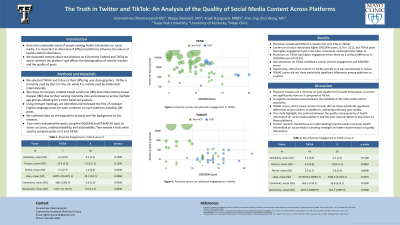Tuesday Poster Session
Category: Practice Management
P4917 - The Truth on Twitter and TikTok: An Analysis of the Quality of Social Media Content Across Platforms
Tuesday, October 29, 2024
10:30 AM - 4:00 PM ET
Location: Exhibit Hall E

Has Audio

Gnanashree Dharmarpandi, MD
Texas Tech University Health Sciences Center
Amarillo, TX
Presenting Author(s)
Gnanashree Dharmarpandi, MD1, Waqas Rasheed, MD2, Anjali Rajagopal, MBBS3, Xiao Jing (Iris) Wang, MD3
1Texas Tech University Health Sciences Center, Amarillo, TX; 2University of Kentucky, Lexington, KY; 3Mayo Clinic, Rochester, MN
Introduction: Given the undeniable trend of people seeking health information on social media, it is important to determine if different platforms influence the nature of health-related information. We evaluated content about 2 diseases on X (formerly Twitter) and TikTok to assess whether the platform type affects the demographics of content creators and the quality of posts.
Methods: We selected TikTok and X due to their differing user demographics: TikTok is primarily used by Gen Z in the US, while X is mainly used by millennials internationally. We chose to compare irritable bowel syndrome and inflammatory bowel disease due to their varying mortality risks and relevance across multiple age groups, allowing for a more balanced analysis. Using relevant hashtags, we identified and reviewed the first 25 relevant English-language posts for each condition on each platform, totaling 100 posts. We collected data on the popularity of posts and the background of the creators. Two raters evaluated the posts using the DISCERN and PEMAT-AV tools to assess accuracy, understandability, and actionability. Two-sample t-tests were used to compare posts on X and TikTok.
Results: Physicians constituted 40% of X creators but only 14% on TikTok . Content on X had a statistically higher DISCERN score (11.9 vs. 10.2), but TikTok posts had higher engagement with more likes, comments, and bookmarks (Table 1). Physicians on TikTok had higher engagement than those on X without difference in DISCERN scores (P >0.05). Non-physicians on TikTok exhibited a similar trend in engagement and DISCERN scores. Importantly, 14% of the content on TikTok and 4% on X was promotional in nature. PEMAT scores did not show statistically significant differences among platforms or creators.<br><br>
Discussion: Physician creators are a minority on both platforms for health information, but there are significantly more on X compared to TikTok. A negative correlation exists between the reliability of the information and its popularity. PEMAT scores, which assess content format, did not show statistically significant differences across creators or platforms, indicating uniformly poor quality. This study highlights the contrast between the quality and popularity of health information on social media platforms and the poor representation of physicians on these platforms. Further research should focus on understanding how the public consumes health information on social media to develop strategies for better dissemination of quality information.
Note: The table for this abstract can be viewed in the ePoster Gallery section of the ACG 2024 ePoster Site or in The American Journal of Gastroenterology's abstract supplement issue, both of which will be available starting October 27, 2024.
Disclosures:
Gnanashree Dharmarpandi, MD1, Waqas Rasheed, MD2, Anjali Rajagopal, MBBS3, Xiao Jing (Iris) Wang, MD3. P4917 - The Truth on Twitter and TikTok: An Analysis of the Quality of Social Media Content Across Platforms, ACG 2024 Annual Scientific Meeting Abstracts. Philadelphia, PA: American College of Gastroenterology.
1Texas Tech University Health Sciences Center, Amarillo, TX; 2University of Kentucky, Lexington, KY; 3Mayo Clinic, Rochester, MN
Introduction: Given the undeniable trend of people seeking health information on social media, it is important to determine if different platforms influence the nature of health-related information. We evaluated content about 2 diseases on X (formerly Twitter) and TikTok to assess whether the platform type affects the demographics of content creators and the quality of posts.
Methods: We selected TikTok and X due to their differing user demographics: TikTok is primarily used by Gen Z in the US, while X is mainly used by millennials internationally. We chose to compare irritable bowel syndrome and inflammatory bowel disease due to their varying mortality risks and relevance across multiple age groups, allowing for a more balanced analysis. Using relevant hashtags, we identified and reviewed the first 25 relevant English-language posts for each condition on each platform, totaling 100 posts. We collected data on the popularity of posts and the background of the creators. Two raters evaluated the posts using the DISCERN and PEMAT-AV tools to assess accuracy, understandability, and actionability. Two-sample t-tests were used to compare posts on X and TikTok.
Results: Physicians constituted 40% of X creators but only 14% on TikTok . Content on X had a statistically higher DISCERN score (11.9 vs. 10.2), but TikTok posts had higher engagement with more likes, comments, and bookmarks (Table 1). Physicians on TikTok had higher engagement than those on X without difference in DISCERN scores (P >0.05). Non-physicians on TikTok exhibited a similar trend in engagement and DISCERN scores. Importantly, 14% of the content on TikTok and 4% on X was promotional in nature. PEMAT scores did not show statistically significant differences among platforms or creators.<br><br>
Discussion: Physician creators are a minority on both platforms for health information, but there are significantly more on X compared to TikTok. A negative correlation exists between the reliability of the information and its popularity. PEMAT scores, which assess content format, did not show statistically significant differences across creators or platforms, indicating uniformly poor quality. This study highlights the contrast between the quality and popularity of health information on social media platforms and the poor representation of physicians on these platforms. Further research should focus on understanding how the public consumes health information on social media to develop strategies for better dissemination of quality information.
Note: The table for this abstract can be viewed in the ePoster Gallery section of the ACG 2024 ePoster Site or in The American Journal of Gastroenterology's abstract supplement issue, both of which will be available starting October 27, 2024.
Disclosures:
Gnanashree Dharmarpandi indicated no relevant financial relationships.
Waqas Rasheed indicated no relevant financial relationships.
Anjali Rajagopal indicated no relevant financial relationships.
Xiao Jing (Iris) Wang indicated no relevant financial relationships.
Gnanashree Dharmarpandi, MD1, Waqas Rasheed, MD2, Anjali Rajagopal, MBBS3, Xiao Jing (Iris) Wang, MD3. P4917 - The Truth on Twitter and TikTok: An Analysis of the Quality of Social Media Content Across Platforms, ACG 2024 Annual Scientific Meeting Abstracts. Philadelphia, PA: American College of Gastroenterology.
